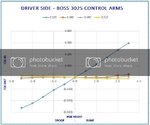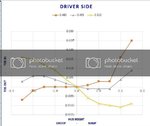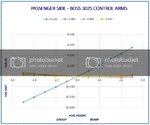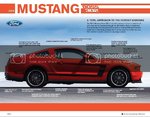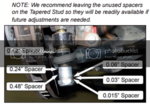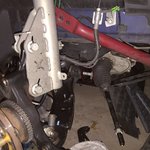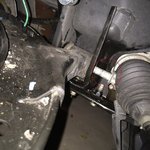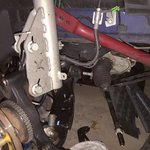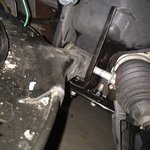Hello,
I was curious to hear from folks who have installed or use a Bump Steer correction Tie Rod on their car and if anyone knows of alternative methods for setting up the adjustable Tie-Rods without the need to remove the entire front strut assembly as documented by Maximum Motorsports.
I recently picked up some Boss 302S Front A Arms as well as the Boss 302S Bump Steer kit which I plan to install in the coming weeks. While I am ready to roll up my sleeves and dive head first into the "process" of measuring and correcting any Bump Steer found I would certainly not object to hearing about easier alternative methods which can achieve the same goal, if one exists.
Let me bounce an idea off you guys first though that I have had rolling around in my head for while and see if you agree or disagree whether or not this could be a viable "Alternative" approach to correcting Bump Steer.
But first, I will explain what I believe to be the ultimate goal of what one is attempting to do when they are trying to correct Bump Steer. My understanding of the goal in Bump Steer correction is that you are attempting to correct the angle that the Tie Rod is set to so that in the end it follows the same Arc and Plane of the A Arms when the car is moving about Vertically during suspension travel. In general, on a lowered car the Tie Rods tends to be on a different, more aggressive angle then the A Arms. On a stock car straight off the factory floor the Tie Rods are parallel with the A Arms.
Assuming any of the above explanation is correct here is the Bump Steer correction approach I have been thinking about which seems, in theory, like it may work but I would like to hear others opinion on this as well.
So the Alternative approach goes like this:
1. Start with car either on the ground or the front of the car up on ramps with wheels straight ahead
2. Take a Digital Angle finder and rest it along the bottom, straight flat edge of the Front A Arms and document the Angle shown by the gauge
3. Repeat Step # 2 for both Driver & Passenger Sides of the car
4. Take a Digital Angle finder and rest it along the bottom, straight flat edge of the Tie Rods and document the Angle shown by the gauge
5. Repeat Step # 4 for both Driver & Passenger Sides of the car
6. Calculate the difference in Angles between the A Arms and the Tie Rods
7. Use the supplied Washer Stacks that came with the Bump Steer correction kit to make the angle of the Tie Rods the same as the A Arms
8. Torque everything down to Spec and your done
Please let me know how many holes are in my theory or if you agree that it would achieve the same goal as the longer, more involved process of Bump Steer correction.
Thanks for any info and experience you can provide
I was curious to hear from folks who have installed or use a Bump Steer correction Tie Rod on their car and if anyone knows of alternative methods for setting up the adjustable Tie-Rods without the need to remove the entire front strut assembly as documented by Maximum Motorsports.
I recently picked up some Boss 302S Front A Arms as well as the Boss 302S Bump Steer kit which I plan to install in the coming weeks. While I am ready to roll up my sleeves and dive head first into the "process" of measuring and correcting any Bump Steer found I would certainly not object to hearing about easier alternative methods which can achieve the same goal, if one exists.
Let me bounce an idea off you guys first though that I have had rolling around in my head for while and see if you agree or disagree whether or not this could be a viable "Alternative" approach to correcting Bump Steer.
But first, I will explain what I believe to be the ultimate goal of what one is attempting to do when they are trying to correct Bump Steer. My understanding of the goal in Bump Steer correction is that you are attempting to correct the angle that the Tie Rod is set to so that in the end it follows the same Arc and Plane of the A Arms when the car is moving about Vertically during suspension travel. In general, on a lowered car the Tie Rods tends to be on a different, more aggressive angle then the A Arms. On a stock car straight off the factory floor the Tie Rods are parallel with the A Arms.
Assuming any of the above explanation is correct here is the Bump Steer correction approach I have been thinking about which seems, in theory, like it may work but I would like to hear others opinion on this as well.
So the Alternative approach goes like this:
1. Start with car either on the ground or the front of the car up on ramps with wheels straight ahead
2. Take a Digital Angle finder and rest it along the bottom, straight flat edge of the Front A Arms and document the Angle shown by the gauge
3. Repeat Step # 2 for both Driver & Passenger Sides of the car
4. Take a Digital Angle finder and rest it along the bottom, straight flat edge of the Tie Rods and document the Angle shown by the gauge
5. Repeat Step # 4 for both Driver & Passenger Sides of the car
6. Calculate the difference in Angles between the A Arms and the Tie Rods
7. Use the supplied Washer Stacks that came with the Bump Steer correction kit to make the angle of the Tie Rods the same as the A Arms
8. Torque everything down to Spec and your done
Please let me know how many holes are in my theory or if you agree that it would achieve the same goal as the longer, more involved process of Bump Steer correction.
Thanks for any info and experience you can provide
